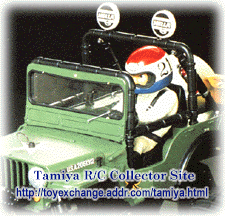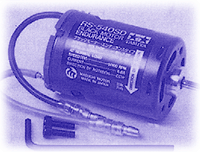What should I look for in a used Tamiya?
The more complete the better...
When buying old collectable Tamiyas, the rule of the thumb that I’ve always used is that the older the car, the more complete it should be. The availability (and cost) of spare parts rises directly with the age of the vehicle. And for a few of the very first cars, finding some parts are getting to be impossible.
 So when you’re purchasing these older Tamiyas be very cautious on how much you pay for an incomplete or poor condition car. Take for example the Tamiya Sand Scorcher. A mint brand new car painted in the correct colors can fetch up to $1000.00 on the open market. And a used poor condition one (missing the body and some other parts) can still go for $100.00.
So when you’re purchasing these older Tamiyas be very cautious on how much you pay for an incomplete or poor condition car. Take for example the Tamiya Sand Scorcher. A mint brand new car painted in the correct colors can fetch up to $1000.00 on the open market. And a used poor condition one (missing the body and some other parts) can still go for $100.00.
But when you calculate the time and effort that it would take to bring the poor condition car up to the standards of the new-built one, you’re much better off buying the mint one. As an example, a brand new front bumper for a Sand Scorcher can cost anywhere from $65 to $125 depending upon market conditions.
Always more than one way to get it done...
In tracking and analyzing the sale and purchase of older Tamiyas I find that many people are "silo’d" into trying to restore their vehicle to mint condition. Which is fine if you have some sentimental attachment to your vehicle or if you're only missing a single critical piece/part.
My experience though is that it is far cheaper to hunt for a new-built car (or even a New In Box kit), strike a reasonable deal for it and then sell your own car to recoupe some of the costs. I’ve found that many times, this is cheaper than trying to restore an old car by replacing all the worn parts. So the next time you’re looking for a hard to find part for your old cars, keep an open mind. Sometimes a better solution is to dump your car and "trade up" to a better condition one.
Learn about Tamiya's Badge-engineering efforts...
Tamiya is famous for releasing the same chassis with a new body and calling it a totally different car kit. If you stay on top of which kits use the same chassis, you might be able spot a good deal that others will miss.
For example, I've found that Tamiya Blackfoots hold their value very well. Even run down examples still fetch average coin. But the Mudblaster (which is far less popular) may sell for less. Both chassis' are identical, you could swap the bodies between the two and be hard pressed to tell the difference. The same can be said for things such as the Grasshopper, Hornet, and Fire Dragon which are basically the same car with few modifications.
Knowing about badge engineering is vitally important when you're purchasing parts. A part that is labelled for one car kit may be identical to the part you require for your car, but is overlooked by the buyer because they're not certain whether it would fit.
The little bits count...
 When purchasing a car, inquire about such things as instruction manuals, boxes and other accessories or packaging material that may have come with the original vehicle. For collectors, these ancillary items are very important to the overall presentation of the car. Boxes are of special importance because of the colorful artwork that Tamiya used. On a more practical note, the instruction manual will assist when it comes time for repairs or restoration work.
When purchasing a car, inquire about such things as instruction manuals, boxes and other accessories or packaging material that may have come with the original vehicle. For collectors, these ancillary items are very important to the overall presentation of the car. Boxes are of special importance because of the colorful artwork that Tamiya used. On a more practical note, the instruction manual will assist when it comes time for repairs or restoration work.
And in the "little bits" department, frequently people sell their cars without the radio gear but neglect to put back the little bits that connect the servos to the steering assembly or speed control unit. Heck, sometimes they don't bother to throw in the original 3 speed controller! These little items are important, always
